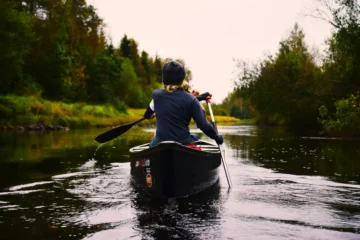Here’s how to do it right. First, choose a suitable vehicle. A car with a roof rack works best. Next, place the canoe on the rack. Ensure it sits evenly. Use straps to secure it. Tighten them well, but only a little.
This prevents damage. Check the front and back. They should have extra lines for stability. Finally, do a double-check. Make sure everything is firm and secure.
Now, you’re ready to hit the road. Remember, safety is crucial. Take your time and transport your canoe the right way. Read on to learn more about tips & techniques.
Key Takeaways:
- Pick the right transportation method for your canoe.
- Properly load and secure your canoe with care.
- When carrying multiple canoes, ensure balance and secure each one individually for safety.
How to Transport a Canoe?
Transporting a canoe with ease is the key to embarking on unforgettable water adventures. Here, we’ll provide you with expert tips and step-by-step instructions on how to transport a canoe safely and hassle-free.
Step 1: Preparing Your Canoe For Transport
Before transporting your canoe, check it carefully.
- Look for cracks or damage. This step is crucial for safety.
- Next, gather your gear. You need strong straps, foam blocks, and a roof rack or trailer.
- Make sure these items are in good shape. They secure the canoe during travel. This preparation is key.
It ensures a safe and smooth journey for your canoe.
Step 2: Choosing the Right Transportation Method
Selecting the right method to transport your canoe is vital. It ensures safety and ease. Let’s explore the options.
Vehicle Roof Racks: Types and Installation
- Fixed Roof Racks: These racks attach directly to your vehicle. They are stable and can carry heavy loads. Installation is a one-time task. Once installed, they are always ready for use. Ideal for frequent canoe transporters.
- Removable Roof Racks: These are versatile and fit most vehicles. They are great for occasional use. Easy to install and remove, they are less sturdy than fixed racks. Good for light canoes and short trips.
Using Trailers for Canoe Transport
Trailers are perfect for long trips and multiple canoes. They are easy to load and unload. Consider a trailer if you have a heavy canoe or transport canoes often. Trailers reduce the strain on your vehicle’s roof. They are ideal for long-distance travel.
Alternative Methods: Canoe Carts and Carriers
Canoe carts and carriers are useful for short distances. They are easy to maneuver and great for solo travelers. Carts work well on varied terrains. The downside is they are not suitable for long distances. They are a good choice for transporting from your vehicle to the water.

Step 3: Step-by-Step Guide to Loading and Securing a Canoe
Loading and securing your canoe correctly is essential. It ensures safety on the road. Let’s break down the process.
Loading a Canoe onto a Vehicle Roof Rack
- Position the Canoe: Place the canoe upside down on the rack. The hull should face the sky. This position offers more stability.
- Lift Carefully: Lift the canoe with another person if possible. Keep your back straight and lift with your legs.
- Center the Canoe: Ensure the canoe is centered on the rack. It should not extend too far on either side of the vehicle.
- Safety Tips: Always check the vehicle’s manual for weight limits. Avoid lifting heavy canoes alone.
Securing the Canoe: Strapping and Tying Techniques
- Use Cam Buckle Straps: These straps are easy to tighten and release. They secure the canoe without damaging it.
- Strap Placement: Place straps over the canoe’s hull. Secure them at the front and back of the roof rack.
- Tighten Securely: Tighten the straps so the canoe is firm. It should not move side to side or front to back.
- Check Regularly: During travel, stop and check the straps. They can loosen over time.
Using Trailers: Loading and Securing Tips
- Position the Canoe: Center the canoe on the trailer. Use the trailer’s guidelines for positioning.
- Secure with Straps: Use straps to tie down the canoe. Attach them to designated points on the trailer.
- Extra Safety: For long trips, consider additional tie-downs. Secure the canoe’s front and back to the trailer.
- Check the Trailer’s Condition: Before loading, ensure the trailer is in good condition. Check tires, lights, and connections.
Following these steps will help you transport your canoe safely and efficiently. Remember, safety is the priority. Take your time and double-check everything.

Transporting Multiple Canoes
Transporting more than one canoe requires careful planning. It’s about balance and security. Let’s explore how to do it right.
Strategies for Carrying More Than One Canoe
- Use a Large Roof Rack or Trailer: Ensure your roof rack or trailer can hold multiple canoes. Check the size and weight capacity.
- Stacking Canoes: If using a roof rack, stack canoes carefully. Place the bottom canoe upside down. Stack the next one on top, also upside down. This method saves space.
- Use Foam Blocks: Place foam blocks between each canoe. This prevents damage from friction.
- Secure Each Canoe Individually: Strap each canoe separately. This provides better stability. Use extra straps if needed.
- Check Weight Distribution: Balance the weight evenly. This is crucial for safe driving. An uneven load can cause handling problems.
- Double-Check Everything: Before you drive, check all straps and the overall setup. Make sure everything is secure.
By following these steps, you can transport multiple canoes safely. Always prioritize safety and stability. Take your time to secure each canoe properly.
Final Words
To sum it up, safe and efficient canoe transport is the first step towards your next memorable water adventure. From careful preparation and choosing the right method to loading and securing your canoe, these steps ensure a smooth and secure journey.
Prioritizing safety and taking your time are the keys to transporting your canoe hassle-free and enjoying the great outdoors to the fullest.





[…] Tips for Safe Canoeing: Always wear a life jacket. Learn basic paddling and steering skills. Check the weather before you go. Don’t overload your canoe. Stay alert to water conditions. Now that you’ve built your canoe, discover the best ways to transport it: How to Transport a Canoe. […]